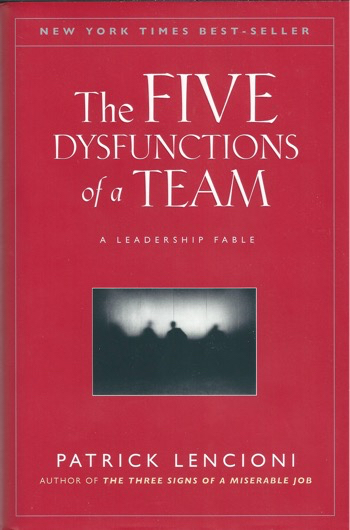 The Five Dysfunctions of a Team by Patrick Lencioni is a eminently readable book, mostly novelized, about why teams fail and what they need to work and perform at a high level. “If you could get all the people in an organization rowing in the same direction, you could dominate any industry, in any market, against any competition, at any time.”, Quotes Lencioni in his introduction. My intuition and experience agrees.
The Five Dysfunctions of a Team by Patrick Lencioni is a eminently readable book, mostly novelized, about why teams fail and what they need to work and perform at a high level. “If you could get all the people in an organization rowing in the same direction, you could dominate any industry, in any market, against any competition, at any time.”, Quotes Lencioni in his introduction. My intuition and experience agrees.
The Five Dysfunctions of a Team was recommended to me by my friends and Chic Communications. I finally decided to pick it up because Petruzzo Photography is expanding its talent and I don’t want to just build a working company, I want to build an amazing one. This book was a real page-turner.
The lessons of the book, and the bulk of the words therein, are delivered in a fable about Katherine. She is the new CEO of the fictional tech company DecisionTech, Inc who is in the grips of a far reaching and nasty habit for corporate politics. Everyone’s tip toeing around each other and no one’s brilliance is able to make its most meaningful impact.
In the story, Katherine begins her assignment by observing team meetings for a few weeks. Soon, she arranges for a series of trips away from the office with the executive staff in Napa Valley. While on retreat, Katherine attempts to get to the bottom of the dysfunction, and rebuild something healthier and more productive in its place.
She presents a pyramid diagram, like the food pyramid, but about team-limiting problems.
They are, at the bottom “an absence of Trust”, then a “Fear of Conflict”, followed by a “Lack of Commitment”, an “Avoidance of Accountability” and finally, as the capstone, an “Inattention to Results”.
Katherine’s team balks at first, but gradually warms up to her and the concept she’s espousing. Through the course of these team get-aways, Katherine’s team loses two naysayers, but as a result is able to find an excellent way to restructure themselves and exceed their goals.
It’s not hard to see how the Five Dysfunctions are interconnected. Trust—not the pattern matching kind, but rather the kind of trust that allows people to be vulnerable with each other—undergirds all really effective teams. It’s that kind of trust that makes it possible to engage in productive conflict. Productive conflict lets everyone feel heard and make firm commitments, even if they don’t love the idea. Commitment is what makes accountability possible. And finally, accountability requires we look at the real results.
The Five Dysfunctions of a Team was an easy read—entertaining and insightful and recommended by people I deem worthy of extra respect. There are no real chapters, instead it’s broken into just two main parts, “the Fable” and “the Model”. However, each part is broken into very small 5 to 10 minute sections. The whole book cost me just shy of 3 hours to read.
If you’re building a team, or trying to repair the one you have, this is a good excuse to stop working for a bit.

Recent Discussion